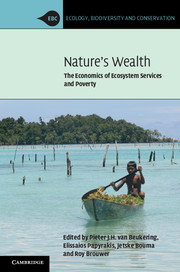Book contents
- Frontmatter
- Contents
- List of contributors
- Acknowledgements
- 1 The economics of ecosystem services and poverty
- Part I Biodiversity-related ecosystem services
- Part II Marine-related ecosystem services
- Part III Forest-related ecosystem services
- Part IV Water-related ecosystem services
- 12 Small-scale water harvesting and household poverty in northern Ethiopia
- 13 Water services, dam management and poverty in the Inner Niger Delta in Mali
- 14 The environmental and social impacts of flood defences in rural Bangladesh
- 15 Double dividends of additional water charges in South Africa
- Part V Land-related ecosystem services
- Index
- References
13 - Water services, dam management and poverty in the Inner Niger Delta in Mali
Published online by Cambridge University Press: 05 July 2013
- Frontmatter
- Contents
- List of contributors
- Acknowledgements
- 1 The economics of ecosystem services and poverty
- Part I Biodiversity-related ecosystem services
- Part II Marine-related ecosystem services
- Part III Forest-related ecosystem services
- Part IV Water-related ecosystem services
- 12 Small-scale water harvesting and household poverty in northern Ethiopia
- 13 Water services, dam management and poverty in the Inner Niger Delta in Mali
- 14 The environmental and social impacts of flood defences in rural Bangladesh
- 15 Double dividends of additional water charges in South Africa
- Part V Land-related ecosystem services
- Index
- References
Summary
Introduction
Mali’s Poverty Reduction Strategy Paper (PRSP) constitutes the sole framework for Mali’s development policies and poverty reduction strategies (GoM 2002). This influential document highlights the need to exploit the country’s hydro-electric and hydro-agricultural potential in the order of 5000 GWh/annum and 2 million hectares, respectively.
A review of the PRSP by the International Development Association (IDA) and the International Monetary Fund (IMF) confirms this, and states, ‘further development of Mali’s untapped hydrological potential is a critical need, as it directly addresses one of Mali’s core vulnerabilities, that of the temporal and spatial variability in rainfall, as well as the uncertainty of climatic conditions’ (IDA and IMF 2003). Although Mali’s hydro-electric and hydro-agricultural potential has yet to be fully realized, it is widely questioned whether the costs and benefits of such mega-investments are properly estimated. Besides the economic feasibility (i.e. direct costs and benefits) of additional dams, it is still unclear what the indirect effects of hydro-electric and hydro-agricultural schemes are on downstream beneficiaries of rivers.
- Type
- Chapter
- Information
- Nature's WealthThe Economics of Ecosystem Services and Poverty, pp. 283 - 295Publisher: Cambridge University PressPrint publication year: 2013



